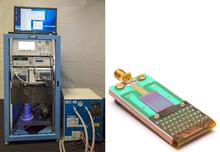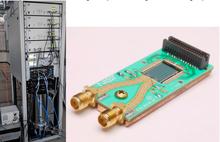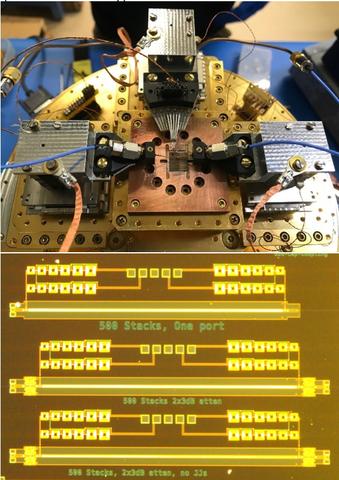Summary
Goal: To develop Josephson voltage standard (JVS) systems to improve the dissemination of primary standards and the accuracy of voltage measurements from DC to audio and radio frequencies. The programmable JVS (PJVS) system realizes quantum-based DC voltages over the range ±10 V. Audio-frequency waveforms with synthesis frequencies from 10 Hz to 1 MHz and root-mean-square (rms) voltages up to 2 V are synthesized with the Josephson arbitrary waveform synthesizer (JAWS) system. We are developing a new system, RF-JAWS, to extend the synthesis frequencies of JAWS up to tens of gigahertz. The cryogenics of our instruments have transitioned from liquid-helium-based to cryocooler-based systems for ease of operation.
Description
Researchers in the Quantum Voltage Project develop and disseminate highly accurate instruments that exploit the quantum mechanical properties of superconductive devices known as Josephson junctions (JJs), as well as measurement techniques and best-practices for using these instruments. When a JJ is driven with a microwave signal, its quantum-mechanical behavior causes it to produce an exactly calculable voltage that depends only on the microwave frequency and fundamental constants. The 2019 redefinition of the International System of Units (the SI) means that all Josephson voltage standards are fundamental realizations of the unit “Volt” because they are all traceable to fundamental constants.

The Quantum Voltage Project has developed three systems: 1) the programmable Josephson voltage standard (PJVS) for DC and low-frequency step-wise voltages up to 10 V; 2) the Josephson arbitrary waveform synthesizer (JAWS) system for rms signals up to 2 V and frequencies up to 1 MHz; and 3) the RF-JAWS system for synthesizing programable signals up to tens of gigahertz in frequency.
Figure 1 shows the PJVS system and a cryopackaged superconducting-integrated circuit chip that are disseminated as part of the NIST standard reference instrument (SRI) program – see https://www.nist.gov/sri. The PJVS system is used to realize voltages in the range of ± 10 V for applications such as the calibration of Zener diode voltage standards and voltmeter range and linearity. The chip used in the 10 V PJVS system contains over 270,000 Josephson junctions.

Figure 2 shows a prototype of the NIST JAWS system in a configuration that produces 4 V root-mean-square (rms). The JAWS SRI system, which is disseminated at https://www.nist.gov/sri, produces arbitrary waveforms with quantum-based amplitudes up to 2 V rms across a broad bandwidth of 10 Hz to 1 MHz. The 2 V JAWS system uses superconducting circuits with over 100,000 Josephson junctions. JAWS systems are used to calibrate AC test equipment, namely thermal converters and AC voltmeters, and as the precision source in a digital impedance bridge for calibrating impedances.

The Quantum Voltage Project is also developing a new instrument, the RF-JAWS system, to synthesize waveforms at frequencies up to tens of gigahertz. A prototype RF-JAWS chip is shown in Figure 3 mounted inside a cryogenic probe station that is used for research and development. This system is being used to develop new RF calibration techniques that will improve the measurement and calibration of RF signals, particularly for the new 5G and 6G communications technologies, as well as for quantum information applications.

